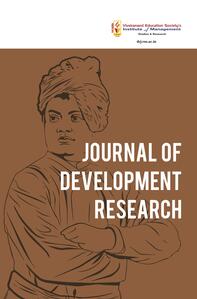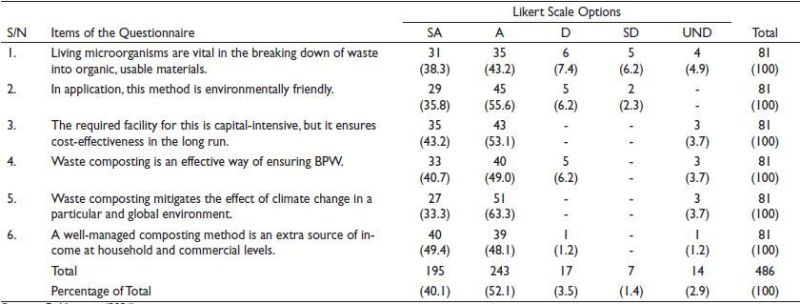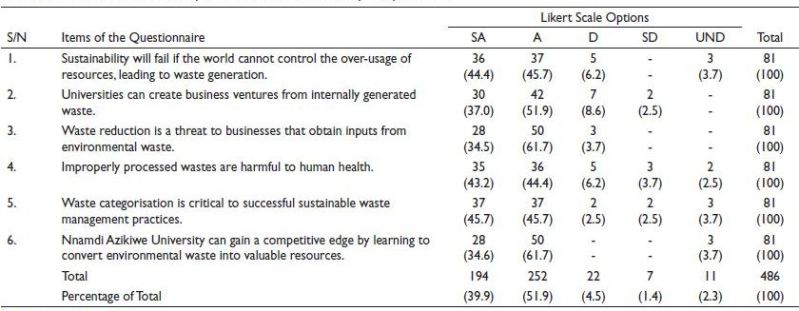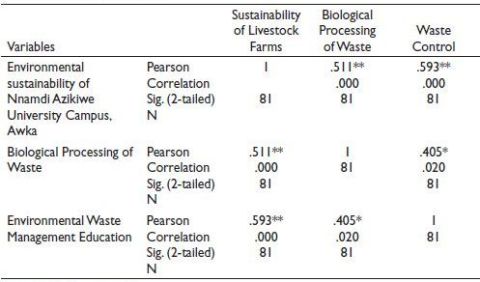
1 Department of Business Administration, Nnamdi Azikiwe University, Awka, Nigeria
Creative Commons Non Commercial CC BY-NC: This article is distributed under the terms of the Creative Commons Attribution-NonCommercial 4.0 License (http://www. creativecommons.org/licenses/by-nc/4.0/) which permits non-Commercial use, reproduction and distribution of the work without further permission provided the original work is attributed.
Nigeria’s rising population makes waste generation an inevitable endeavour. In the journey of national development, waste generation is static. With a population of over 170 million, Nigeria produces a staggering volume of solid waste, of which less than 20% is collected through a formal system. Waste generation on the Nnamdi Azikiwe University campus, Awka, has remained contentious as generated waste is neither categorised nor recycled for re-usage purposes. The survey research method was adopted for this research, with the questionnaire utilised as research instrument. This study included the entire population due to size manageability. Statistically, descriptive and inferential statistical analyses were fit for purpose and, hence, utilised. Findings revealed that biological processing of waste and environmental waste management education would result in the environmental sustainability of the Nnamdi Azikiwe University campus, Awka. This study recommends that the university management prioritise building a biological waste processing facility and champion the creation of environmental waste management education awareness for improved harmful waste generation and control.
Solid waste management, biological processing of waste, waste control, waste management education, environmental sustainability
Introduction
In the economic development and advancement journey, waste generation remains inevitable. However, it is crucial to control waste generation in the interest of public health and the overall protection of the environment. Wastes as by-products of human activities vary according to economic engagements and household consumptions. There is a global concern regarding solid waste generation in megacities and rural settlements. Rapid urbanisation, economic development and population growth have increased waste generation rates, posing diverse environmental and public health risks. As the population increases, it becomes difficult to manage waste generation. The issue of waste accumulation in urban areas stems from suboptimal waste management practices, which pose significant environmental disruptions and challenges to human life. The negative impact of urban development is the increasing complexity of solid waste management (SWM) problems. The rate at which solid waste is produced outpaces the ability to handle it in an environmentally responsible manner. Waste is produced by various industries, including commercial, industrial and household. The U.N. Environment Program reports that about a significant percentage of wasted food, amounting to 60%, came from households. In comparison, an estimated 28% came from food service operations, such as restaurants. The challenges associated with waste management in urban settlements revolve around the absence of viable waste management techniques. With a population of 170 million, Nigeria produces a staggering volume of solid waste, of which less than 20% is collected through a formal system. Economic, institutional, legislative, technical and operational constraints affect the existing SWM system, highlighting the enormity of the task. However, implementing sustainable waste management practices could significantly alleviate these issues. Nigeria’s inability to sustainably manage solid waste has left the environment in ruins, where the spread of bacteria has resulted in avoidable healthcare visitation and even these healthcare facilities are currently overwhelmed. Nigeria generates over 32 million tonnes of solid waste yearly from households, local industries, artisans and traders who litter the immediate surroundings; sadly, only a fraction is collected. Recently, these wastes have been inefficiently managed, thus resulting in unethical disposal of waste.
Universities in Nigeria generate significant amounts of solid waste in various forms and volumes. At Nnamdi Azikiwe University, Awka, which is the focus of this study, SWM practices are low compared to institutions that self-manage internally generated waste. The quantity of generated waste in the institution is neither categorised nor sustainably disposed of. The core practice of disposing of waste within the citadel is usually burning, and in most cases, it is done close to learning centres. Covenant University, Sango-Ota Ogun state, manages waste generation through its institutional self-owned waste disposal systems utilising delivery trucks to convey waste to municipal landfill sites (Okeniyi and Anwan, 2012). This is the known practice of SWM in developing countries. Solid waste characterisation is a problem experienced across government-owned universities in Nigeria. In a documented study, Adeniran et al. (2017) reveal that the University of Lagos, Akoka campus generates an average of 32.2 tonnes of waste daily during the year, which is never sorted or characterised. The wastes generated at Nnamdi Azikiwe University include food waste, polythene bags, plastic bottles, disposable food packs, electrical appliances, papers, wood, sachet water (aka Pure water) and building materials. Sadly, these wastes are never periodically collected, categorised or sorted for recyclable purposes by the university management through its sustainable development directorates. Allowing these wastes, especially plastics whose end-of-life management is complex, becomes hazardous to the environment and students' health. Worse still, the non-existence of waste generation data measured in tonnes within the institution presents daunting challenges. Understanding students’ perceptions of SWM and sustainability is crucial research for environmental science and waste management professionals. This research is of paramount importance as it intends to shed light on the role of students in shaping the future of waste management and sustainability. As a result, this study aims to assess students' perceptions of the efficacy of biological waste processing and environmental waste education in ensuring environmental sustainability at Nnamdi Azikiwe University, Awka, Nigeria.
Solid Waste Management
Improper SWM remains a societal problem, as the inability to curtail waste generation and management has implications for environmental performance. Gobai et al. (2020) reveal that poor waste management can significantly degrade environmental quality within urban areas. The Shakti plastic industry (2021) defines SWM as safe and environmentally responsible waste collection, treatment and disposal. The need to develop urban waste management programmes should not be undermined in achieving waste management. An urban waste management programme should include strategic planning, regulatory and policy frameworks, community participation, financial management, institutional capacity building, research and development and inspection and corrective action (Margallo et al., 2019). While waste collecting is vital for environmental performance and sustainability, waste collection patterns are significant. The handling of SWM in Nigeria calls for immediate attention and the adoption of the best practicable environmental approach towards preserving the environment (Nwosu and Chukwueloka, 2020). Nigeria generates over 32 million tonnes of solid waste annually, but only a fraction is collected (Bakare, 2020). In achieving a sustainable SWM strategy, all waste management steps must be fully functional and practical (Nwosu and Chukwueloka, 2020). Waste categorisation is crucial to an effective waste management system. Waste categorisation ensures that generated wastes are segregated according to specificity. Regarding this study, environmental education and the biological processing of waste (BPW) will be assessed.
Biological Treatment of Waste and Environmental Waste Management Education
Biological treatment is an attractive technology that converts organic compounds into less harmful end products such as CO2 and H2O; compared to physical or chemical methods for removing contaminants, it is considered low-cost and environmentally friendly (Nur et al., 2022). Biological treatments rely on bacteria, nematodes or other tiny organisms to break down organic wastes using normal cellular processes (Fluence, 2024). Globally, this method has been termed cost-effective compared to mechanical and chemical processes. Biological treatment is usually divided into aerobic and anaerobic processes. Aerobic refers to a process in which oxygen is present, while anaerobic describes a biological process in which oxygen is absent (Fluence, 2024). The biological waste management technologies include composting, incineration, landfill, anaerobic digestion and bioconversion to produce biofuels, that is, bioethanol, biodiesel and biogas (Sajid et al., 2023). Although biological wastewater treatment seems simple on the surface, it is a complex process at the intersection of biochemistry and biology, where natural processes help disintegrate organic constituents (Pincy, 2020).
Waste management, or waste reduction, refers to the efforts and strategies to minimise waste generation, disposal and environmental impact. In the management and control of waste, the place of environmental education is of paramount importance. That lack of environmental education in the form of teachings and awareness about waste management and ignorance of the harmful effects on man and the environment has further complicated the problem. Education and awareness of waste and waste management are increasingly important from a global perspective of resource management (Kumar and Kumar, 2022). Villanueva (2013) emphasised that education is one of the four critical components of having a good SWM programme. Nolasco, Baguia and Padua (2019) reiterate that poor information dissemination strategy on SWM makes the public less aware and less participative in the programme.
Environmental Sustainability of University
Environment
The university environment is a training ground for graduates expected to contribute meaningfully to societal growth and development. The number of graduates from older universities may run into thousands or even millions. The focus on the sustainability of the university environment rests on institutions that have, over the years, been able to curtail and even manage the level of generated waste to ensure environmental sustainability and reduce the adverse effect of improper waste management on the environment and people. Regarding the environmental sustainability of the university environment, the University of Bolton (2024) recognised that nine out of ten people in the world currently breathe polluted air and that almost 80% of the world’s plastic ends up in landfills or the natural environment decided to establish a sustainability committee in ensuring good practice among student, staff and community. Higher institutions must become sustainable institutes of learning. A sustainable university is an educational institution that educates global citizens about sustainable development, offers relevant insights on urgent societal challenges, reduces the environmental and social footprints of its campus operations, empowers students and staff to act and makes sustainability a central priority (Rootability et al., 2024). Furthermore, Velazquez et al. (2006) define a sustainable university as a higher educational institution, as a whole or as a part, that addresses, involves and promotes, on a regional or a global level, the minimisation of adverse environmental, economic, societal and health effects generated in the use of their resources to fulfil its functions of teaching, research, outreach and partnership and stewardship in ways to help society make the transition to sustainable lifestyles. A sustainable university campus should be a healthy campus environment with a prosperous economy through energy and resource conservation, waste reduction and efficient environmental management, and promote equity and social justice in its affairs and export these values at community, national and global levels (Alshuwaikhat and Abubakar, 2008). The University of Lagos, Nigeria, is currently attempting to ensure the sustainability of the university campus through its sustainability challenge. The University of Lagos Environmental Sustainability Challenge is a campus drive to track, collect and recycle plastic bottles to increase community participation in sustainable waste management practices in the university (Unilag Communication Unit, 2024). In addition to the ongoing challenge, participants are exposed to circular economic models to imbibe sustainability practice within the University environment.
Hypotheses Development
Based on the literature review, the study developed two hypotheses to ascertain the degree of relationship and inter-relationship between and among the study variables. Hence, these hypotheses are thus stated in their alternate form;
HA1: A positive and significant relationship exists between the biological treatment of waste and environmental sustainability of Nnamdi Azikiwe University Campus, Awka.
HA1: There is a significant and positive relationship between environmental waste management education (EWME) and the environmental sustainability of the Nnamdi Azikiwe University campus, Awka.
Methodology
The survey research method was adopted for this research, with the questionnaire utilised as research instrument. The study population comprised the final year students of two departments in the Faculty of Agriculture at Nnamdi Azikiwe University, Awka. These are the Department of Animal Science and Food Science and Technology. The final year students in the departments are Animal Science (35) and Food Science and Technology (48). As such, the study included the entire population due to size manageability. Regression analysis will be employed for data analyses.
Model Specification
 . [1]
. [1]
Mathematically, the model is specified as;
 [2]
[2]
Where:
ESUC = Environmental sustainability of university campus
BPW = Biological processing of waste
ENE = Environmental education
Data Presentation and Analysis
This section analysed all the data gathered in this study quantitatively, using descriptive and inferential statistics. While descriptive statistics answered the research questions, inferential statistics of correlation and multiple regression analysis verified the various claims of the null hypotheses.
Out of the 83 copies of the questionnaire distributed, 81 returned copies were deemed valid for analysis purposes.
Descriptive Statistical Findings
Research Question One
The research question one sought to establish the effect of biological waste processing on the sustainability of the Nnamdi Azikiwe University Campus, Awka. Accordingly, the respondents' opinions are presented in a Likert scale format in Table 1.
As could be seen from Table 1, 40.1% of the respondents, on average, strongly agreed with all the statements of the items, 51.1% also agreed but not strongly, 3.5% disagreed, 1.4% strongly disagreed, 2.9% were undecided on all the issues raised in the section. Also, variation in opinion across the items indicates that whereas 40.7 and 49% firmly and merely agreed with the statement, 33.3 and 63.3% did so for item 5 respectively. Thus, apart from the averages, there are variations across the items.
Research Question Two
Research question two aims to determine how environmental waste education affects the sustainability of the Nnamdi Azikiwe University campus in Awka. Accordingly, the respondents' opinions on this topic are presented in Table 2 on a Likert scale.
Table 1. Biological Processing of Waste and Sustainability of Nnamdi Azikiwe University Campus, Awka.

Source: Field survey (2024).
Note: (SA = Strongly Agree; A = Agree; D = Disagree; SD = Strongly Disagree and UND = Undecided): (figures in parentheses are percentages).
Table 2. Environmental Waste Management Education and Sustainability of Nnamdi Azikiwe University Campus, Awka.

Source: Field survey (2024).
Note: (SA = Strongly Agree; A = Agree; D = Disagree; SD = Strongly Disagree and UND = Undecided): (figures in parentheses are percentages)
Table 3. Environmental Sustainability of Nnamdi Azikiwe University Campus, Awka.

Source: Field survey (2024).
Note: (SA = Strongly Agree; A = Agree; D = Disagree; SD = Strongly Disagree and UND = Undecided).: (figures in parentheses are percentages)
The analysis of research question two shows that, on average, 37.4% of the respondents strongly agreed with all the statements of the items, 53.1% of them merely agreed with the items, 5.6% disagreed and 1.6% strongly disagreed. In contrast, 2.3% were indifferent to the items raised in the section. However, the analysis shows further that apart from the averages, there are variations across the items. For instance, whereas 39.5 and 53.1% firmly and merely agreed with item 1, 40.7 and 49.4% did so for item 6 respectively.
Table 3 shows that, on average, 39.9% of the respondents strongly agreed with all the statements of the items, 51.9% of them equally agreed but not strongly, 4.5% disagreed, 1.4% strongly disagreed and 2.3% had no opinion on all the issues raised in the section. However, it is also easy to see variations in opinion across the items.
Inferential Statistical Findings: Test of Hypotheses
The correlation analysis in Table 4 shows that strong and positive relationships exist between the dependent and independent variables, and positive but weak relationships exist among the independent variables. However, the absence of multicollinearity considers the model fit for multiple regression analysis.
The result of the ANOVA showed that the F-Statistic has a value of 15.398, and it was considered statistically significant because .000 is less than the P ≤ .05 significant level. Hence, it is suitable for predictions (Table 5).
Table 6 shows the regression coefficient represented by ‘R’ in the table with a value of .491, indicating a 49.1% relationship between the dependent and independent variables. Also, the coefficient of determination or the explanatory power of the variable represented by ‘R2’ in the table with a value of .457 shows that 45.7% variation in the dependent variable can be explained by the independent variables (regressors). The Durbin–Watson statistic of 2.403 is an indication that there is no serial autocorrelation in the data.
Table 4. Correlation Analysis.

Source: SPSS version 23.
* Correlation is significant at .01 level (2-tailed).
** Correlation is significant at .05 level (2-tailed).
Table 5. Summary of Analysis of Variance (ANOVA) for the Model.

Source: SPSS version 23.
a. Predictor: (constant) BPW and EWME.
b. Dependent variable: Sustainability of Nnamdi Azikiwe University Campus, Awka.
Table 6. Summary of Regression Results.

Source: SPSS version 23.
Predictor: (constant) BPW and EWME.
Table 7. Summary of Regression Coefficients, t Values and Significance Levels.

Source: SPSS version 23.
Dependent Variable: Environmental sustainability of Nnamdi Azikiwe University campus, Awka.
Decision Rule I
From Table 7, the coefficient of BPW is .463, and it means that a unit increase in the variable will lead to a 46.3% increase in the environmental sustainability of Nnamdi Azikiwe University campus, Awka when other variables in the model are held constant. From the t value of 3.202 and its corresponding significance level of P.000, the coefficient is significant because P.000 is less than P ≤ .05. Consequently, the null hypothesis was rejected, while the alternative, which suggests that the BPW leads to the environmental sustainability of Nnamdi Azikiwe University campus, Awka.
Decision Rule II
The coefficient of EWME, as presented in Table 7, is .410, and it implies that a unit increase in the variable will lead to a 41% increase in the environmental sustainability of Nnamdi Azikiwe University campus, Awka, if other variables in the model are held constant. Similarly, the t value of 2.459 and its corresponding significance level of .000 are indications that the coefficient is significant because P.000 is less than P ≤ .05. Hence, the null hypothesis was rejected, while the alternative, which suggests that EWME has a significant and positive effect on the environmental sustainability of the Nnamdi Azikiwe University campus, Awka, was accepted.
Discussion of Findings
The first perception findings of the study reveal that the BPW would lead to the environmental sustainability of the Nnamdi Azikiwe University campus, Awka. The realisation of this intent would require investing in the building of a biological processing facility. Though it will require huge capital, it guarantees a profitable return. In this facility, biological microorganisms are vital for the breaking down of waste into organic and usable materials. Effectively, a well-managed composting facility is an extra source of income for universities and even households. Past studies by Cai et al. (2023) show that many microorganisms expected to be involved in plastic biodegradation have not been thoroughly explored. As such, they revealed significant potential for employing various bacterial strains to degrade plastics to improve human health and environmental safety efficiently. Furthermore, V. Afshar et al. (2023) advocates supporting responsible future production and use of biodegradable plastics in various products, including assessing alternatives to conventional plastics. The second study finding is that EWME significantly improves the environmental sustainability of the Nnamdi Azikiwe University campus in Awka. This implies that properly educating communities and creating waste management awareness will improve environmental safety and campus sanity. It should also be stated that through waste management education, the development of a waste control strategy will be realised when proper mechanisms are put in place for a smooth educational process. Finally, university waste control strategies can effectively be developed through waste management education for improved environmental sustainability.
Conclusion and Recommendations
This study assesses students' perceptions of the efficacy of biological waste processing (BPW) and EWME in ensuring environmental sustainability at Nnamdi Azikiwe University, Awka, Nigeria. Biological waste processing and EWME were the measured indices of SWM. The unavailability of data regarding waste generation on the university campus presents research limitations. From students' perception, SWM measurement indices of BPW and EWME positively correlate with the environmental sustainability of the Nnamdi Azikiwe University campus, Awka. The findings imply that investing in biological waste processing facilities on university campuses where a large quantity of waste is generated will, in the long run, yield a profitable return and ensure a sustainable and healthy campus environment for students, staff and visitors. Similarly, consciously creating awareness of EWME through workshops and community development services will equally amount to a sustainable university environment for learning and transferring knowledge needed for improved environmental outcomes. Based on the findings of this study, these recommendations are suggested:
Declaration of Conflicting Interests
The authors declared no potential conflicts of interest with respect to the research, authorship and/or publication of this article.
Funding
The authors received no financial support for the research, authorship and/or publication of this article.
ORCID iD
Henry Sonna Ojukwu https://orcid.org/0009-0006-2708-7304
Adeniran, A., Nubi, T., & Adelopo, A. (2017). Solid waste generation and characterisation in the University of Lagos for sustainable waste management. Waste Management, 67, 3–10.
Alshuwaikhat, H. M., & Abubakar, I. (2008). An integrated approach to achieving campus sustainability: assessment of the current campus environmental management practices. Journal of Cleaner Production, 16, 1777–1785.
Bakare, W. (2020). Solid waste management in Nigeria. Retrieved March 31, 2020, from https://www.bioenergyconsult.com/solid-waste-nigeria/
Cai, Z., Li, M., Zhu, Z., Wang, X., Huang, Y., Li, T., Gong, H., & Yan, M. (2023). Biological degradation of plastics and microplastics: A recent perspective on associated mechanisms and influencing factors. Microorganisms, 11, 1661. https://doi.org/10.3390/microorganisms11071661
Fluence News Team (2024). What is biological wastewater treatment? Available at: https://www.fluencecorp.com/what-is-biological-wastewater-treatment/
Gobai, K. R. M., Surya, B., & Syafri, S. (2020). Kinerja Pengelolaan Sampah Perkotaan: Studi Kasus Kota Nabire Kabupaten Nabire Provinsi Papua. Urban and Regional Studies Journal, 2(2), 37–45. https://doi.org/10.35965/ursj.v2i2.567
Kumar, P., & Kumar, A. (2020). Role of education in waste management. IRE Journals, 4(2), 68–72
Margallo, M., Ziegler-Rodriguez, K., Vázquez-Rowe, I., Aldaco, R., Irabien, Á., & Kahhat, R. (2019). Enhancing waste management strategies in Latin America under a holistic environmental assessment perspective: A review for policy support. Science of the Total Environment, 689, 1255–1275. https://doi.org/10.1016/j.scitotenv.2019.06.393
Nolasco, A., Beguia, P., & Padua, M. (2019). Solid waste management in Naga city: Its culture of information dissemination. Asia Pacific Journal of Multidisciplinary Research, 7(4).
Nur, I., Nor, H., Siti., Z., Siti, H., Roslinda, A., Hesham, A., Daniel, J., & Mohd, F. (2022). Removal of pesticides from water and wastewater by agricultural biomass-based adsorbents. Available at: https://www.sciencedirect.com/topics/earth-and-planetary-sciences
Nwosu, A., & Chukwueloka, H. (2020). A review of solid waste management strategies in Nigeria. Journal of Environment and Earth Science, 132–143. https://doi.org/10.7176/jees/10-6-11
Okeniyi, J. O., & Anwan, E. U. (2012). Solid wastes generation in Covenant university, Ota, Nigeria: Characterisation and implication for sustainable waste management. Journal of Materials and Environmental Science, 3(2), 419–425.
Pincy, A. (2020). A brief overview of the process of biological wastewater treatment. Available at: https://www.researchdive.com/blog/a-brief-overview-of-the-process-of-biological-wastewater-treatment
Rootability Gug & Leuphana University Lüneburg(2024). What is a sustainable university? Available at: https://www.greenofficemovement.org/sustainable-university/
Sajid, M., Akram, A., Fatima Sajjad, S., Siddique, T., & Arshad, M. (2023). Biological Waste Management. IntechOpen. doi: 10.5772/intechopen.1003266
The Shakti Plastic Industry (2021). What is solid waste management. Available at: https://www.shaktiplasticinds.com/what-is-solid-waste-management-all-you-need-to-know/
U.N. Environment Program (2024). UN Estimates World Wastes 19 Percent of Its Food. Available at: https://learningenglish.voanews.com/a/un-estimates-the-world-wastes-19-percent-of-its-food/7551777.html
Unilag Communication Unit (2024). UNILAG Sustainability Challenge 2.0 Gets Underway with 1st Volunteer Orientation and Incentive Presentation Programme. Available at: https://unilag.edu.ng/?p=32142
University of Bolton (2024). Environmental Sustainability. Available at: https://www.bolton.ac.uk/governance/policies-and-legal/environmental-sustainability
V. Afshar, S., Boldrin, A., Astrup, T. F., Daugaard, A. E., & Hartmann, N. B. (2024). Degradation of biodegradable plastics in waste management systems and the open environment: A critical review. Journal of Cleaner Production, 434, Article 140000. https://doi.org/10.1016/j.jclepro.2023.140000
Velazquez, L, Munguia, N., Platt, A., & Taddei, J. (2006). Sustainable university: What can be the matter? Journal of Cleaner Production, 14, 810–819.
Villanueva, R. (2013). Proper solid waste management: Education, engineering, enterprise and enforcement. https://www.philstar.com/business/ science-and-environment